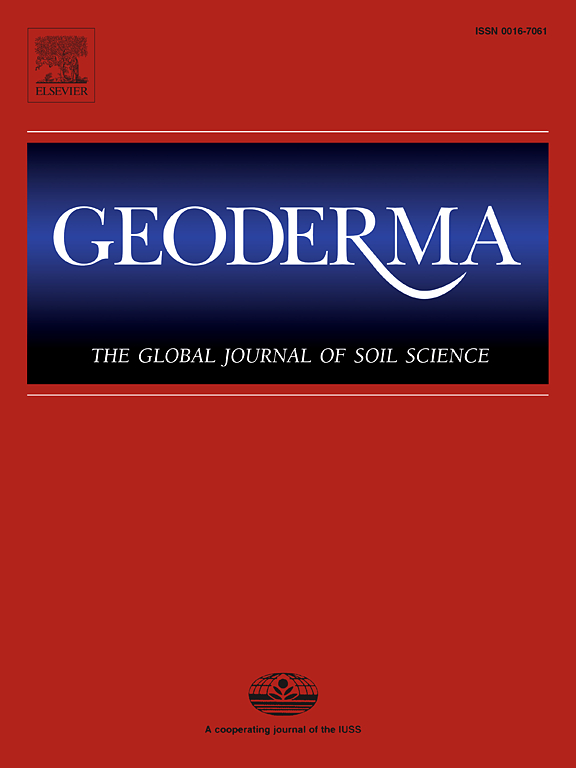深层渗透带的反硝化作用:农业管理含水层补给下硝酸盐淋滤的影响
IF 6.6
1区 农林科学
Q1 SOIL SCIENCE
引用次数: 0
摘要
与专用补给盆地和注入井相比,农业用地管理含水层补给(AgMAR)是一种廉价且广泛的补给形式。然而,关于硝酸盐(NO3 -)在非饱和区的转运和归宿的氮循环结果仍然不确定。采用室内和野外试验相结合的方法,对AgMAR期间表层土壤和地下沉积物的反硝化作用进行了生物地球化学控制。在厌氧条件下进行了乙炔块测定,以确定根区和地下沉积物的鉴定潜力率,这些沉积物来自加利福尼亚中央山谷的一个杏仁园,深达9米。样品要么添加碳(C)和NO3 -进行修饰(电位测定),要么不添加底物(对照),并在三天内测量一氧化二氮(N2O)。反硝化电位测定结果表明,与对照组相比,近地表N2O产量增加了4倍,地下N2O产量增加了49倍。然而,即使没有添加C,在培养过程中,沉积物也能够反硝化地下存在的~ 40%的NO3 -。此外,AgMAR前后田间NO3 - δ15N的测量结果表明,4 m深度的δ15N平均绝对增加4.0‰,表明AgMAR后发生了反硝化作用。统计分析表明,当C浓度较低时,测定中N2O的产生取决于环境控制或土壤/沉积物的地球化学,铁在对照中显著影响反硝化作用,但在反硝化电位测定中没有影响。这些来自实验室孵育和现场的结果初步表明,渗透带具有通过反硝化作用减弱NO3 -的潜力,然而,我们的结果不能精确量化AgMAR下的反硝化N质量,需要更多的工作来确定现场的反硝化速率。未来的研究应侧重于量化AgMAR事件期间和之后的反硝化速率。本文章由计算机程序翻译,如有差异,请以英文原文为准。
Denitrification in the deep vadose zone: implications for nitrate leaching under agricultural managed aquifer recharge
Managed aquifer recharge on agricultural lands (AgMAR) is an inexpensive and extensive form of recharge compared to dedicated recharge basins and injections wells. However, uncertain nitrogen cycling outcomes concerning nitrate (NO3–) transport and fate in the unsaturated zone remain. A combination of laboratory and field experiments were conducted to assess biogeochemical controls on denitrification in surface soils and subsurface sediments during AgMAR. Acetylene block assays were conducted in anaerobic conditions to determine dentification potential rates in the root zone and subsurface sediments collected from an almond orchard down to nine meters in the Central Valley of California. Samples were either amended with carbon (C) and NO3– additions (potential assays) or no substrates were added (control) and nitrous oxide (N2O) was measured over three days. Denitrification potential assays resulted in four times more N2O production near the surface, and 49x more N2O production in the subsurface compared to the control. However, even without additions of C, sediments were able to denitrify ∼ 40 % of the NO3– present in the subsurface during the incubation. Additionally, δ15N of NO3– was measured in the field before and after AgMAR, showing an average absolute increase of 4.0 ‰ in δ15N across 4 m depth suggesting denitrification following AgMAR. Statistical analysis suggests N2O production in assays depends on environmental controls or geochemistry of the soils/sediments when C concentrations are low, with iron significantly influencing denitrification in the control, but not in denitrification potential assays. These results from both laboratory incubations and the field demonstrate initial indications that the vadose zone has the potential to attenuate NO3– via denitrification, however, our results do not allow exact quantification of denitrified N mass under AgMAR, and more work is needed to determine denitrification rates in-situ. Future studies should focus on quantifying denitrification rates in-situ during and immediately following AgMAR events.
求助全文
通过发布文献求助,成功后即可免费获取论文全文。
去求助
来源期刊

Geoderma
农林科学-土壤科学
CiteScore
11.80
自引率
6.60%
发文量
597
审稿时长
58 days
期刊介绍:
Geoderma - the global journal of soil science - welcomes authors, readers and soil research from all parts of the world, encourages worldwide soil studies, and embraces all aspects of soil science and its associated pedagogy. The journal particularly welcomes interdisciplinary work focusing on dynamic soil processes and functions across space and time.
 求助内容:
求助内容: 应助结果提醒方式:
应助结果提醒方式:


